When your child starts a new medication, you’re not just giving them a pill or liquid-you’re stepping into a world of unpredictable reactions. Even the most carefully prescribed drugs can cause side effects, and at home, there’s no nurse or doctor right next to you to help. The good news? Most side effects are mild, and with the right knowledge, you can handle them safely without rushing to the ER. The key is knowing what’s normal, what’s serious, and exactly what to do next.
Know the Common Side Effects
Not every strange behavior or stomach upset means something’s gone wrong. In fact, certain reactions are so common they’re expected. According to data from Children’s Hospital of Philadelphia, gastrointestinal issues are the most frequent: up to 42% of kids on new medications get an upset stomach, and 28% develop diarrhea. Drowsiness happens in about 19% of cases, especially with antihistamines or antibiotics. And surprisingly, some kids become hyperactive instead of sleepy-12% of children on diphenhydramine (like Benadryl) show this unusual reaction, which is rare in adults.Skin rashes appear in 23% of cases, often mild and not allergic. But here’s the catch: if the rash spreads quickly, turns purple or blistered, or is accompanied by swelling of the lips or tongue, that’s not a rash-it’s an emergency. Keep a log: note when the side effect started, how bad it is, and what the child was doing before it happened. This helps your doctor decide if it’s the medication or something else.
Use the Right Tools for Dosing
One of the biggest causes of side effects isn’t the drug itself-it’s how it’s given. A 2023 study from UC Davis Health found that 68% of home medication errors involve wrong dosing. The most common mistake? Using kitchen spoons. A teaspoon isn’t the same as a tablespoon. One teaspoon equals 5 mL. One tablespoon equals 15 mL. Confusing them can mean a threefold overdose.Always use the device that comes with the medication: a 1mL oral syringe with 0.1mL markings. If it didn’t come with one, buy one at the pharmacy-they’re cheap and lifesaving. Never guess. Never eyeball. And never transfer medication to another container, like a water bottle or a jar. A 2022 study by Dr. Lorraine Kelley-Quon showed that doing this increases poisoning incidents by 41% because it removes the safety labels and child-resistant caps.
Another smart trick? Take a photo of the medication label before you give the dose. That way, if you’re unsure later-Did I give this one? Was it the red bottle or the blue one?-you’ve got proof. A 2023 AAP update recommends this step, and early data shows it cuts wrong-medication errors by 44%.
Store Medications Like a Pro
Kids are curious. They climb. They open drawers. They find things. That’s why 72% of pediatric medication emergencies happen in children under five. The solution isn’t just locking things up-it’s locking them up the right way.The American Academy of Pediatrics says: keep all medications at least 1.5 meters (5 feet) high, in a locked cabinet. Not on the counter. Not in a purse. Not in the bathroom. And never in a pill organizer that’s not childproof. The Poison Prevention Packaging Act of 1970 requires child-resistant caps for a reason-92% of them work. But if you take the cap off and leave the bottle on the counter, you’ve undone all the safety.
Also, check storage temperatures. About 73% of liquid pediatric meds need refrigeration. The rest should be kept at 20-25°C (68-77°F). Heat and moisture ruin medicine. A bottle left in a hot car or a steamy bathroom can become ineffective-or even dangerous. Keep meds in a cool, dry place, like a bedroom closet, away from sunlight.
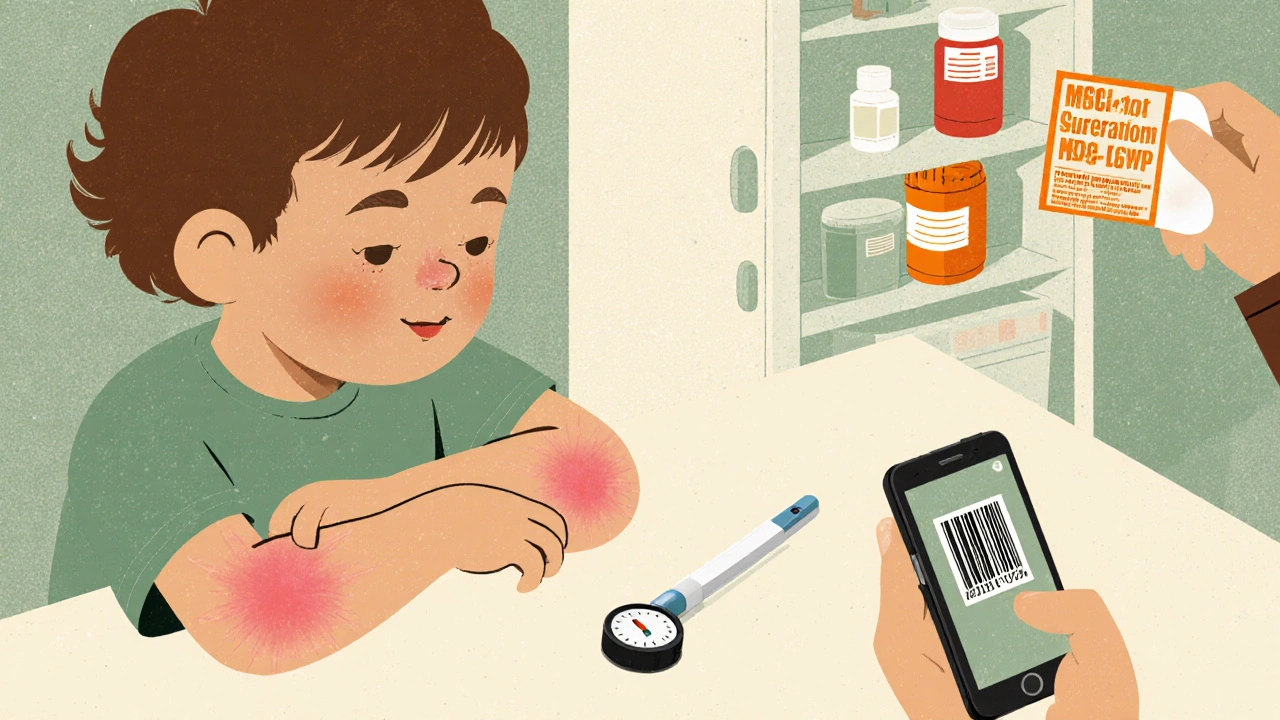
Handle Gastrointestinal Reactions at Home
Nausea, vomiting, diarrhea-these are the most common complaints. The goal? Prevent dehydration. Don’t try to force food or fluids right away. If your child vomits, wait 30 to 60 minutes before offering anything. Start with small sips: 5-10 mL of oral rehydration solution (like Pedialyte) every 5 minutes. If they keep it down for an hour, slowly increase the amount.For diarrhea, avoid juice, soda, or milk. Stick to clear fluids and bland foods. The BRAT diet-bananas, rice, applesauce, toast-is still a solid choice. It’s not magic, but it’s gentle on the gut. Avoid dairy and fatty foods for 24-48 hours. If vomiting lasts more than three times in a few hours, or diarrhea continues for over 24 hours with signs of dehydration (dry mouth, no tears, no wet diaper in 6 hours), call your pediatrician.
Recognize the Red Flags
Most side effects fade. But some need immediate action. The American Academy of Pediatrics says to call your doctor or go to the ER if your child has:- Persistent vomiting (more than 3 episodes in 24 hours)
- Fever over 102°F (38.9°C)
- Difficulty breathing (more than 40 breaths per minute for infants, more than 30 for older kids)
- Swelling of the face, lips, or tongue
- Hives covering more than 10% of the body
- Unresponsiveness or extreme lethargy
If any of these happen, don’t wait. Call 911 or go to the nearest emergency room. For known allergies, if you have an epinephrine auto-injector (like an EpiPen), use it right away. Even if symptoms seem to improve, you still need to go to the hospital afterward. Anaphylaxis can come back.
Don’t Stop Antibiotics Early
It’s tempting. Your child feels better after two days. The cough is gone. Why keep giving the medicine? Because stopping early is one of the biggest mistakes parents make. Children’s Healthcare of Atlanta found that 29% of bacterial infections come back because antibiotics were stopped too soon. The bacteria don’t die-they adapt. And next time, the same drug won’t work.Finish the full course-even if your child seems fine. If side effects are too bad, talk to your doctor. They might switch the antibiotic or give something to help with stomach upset. But never stop on your own.
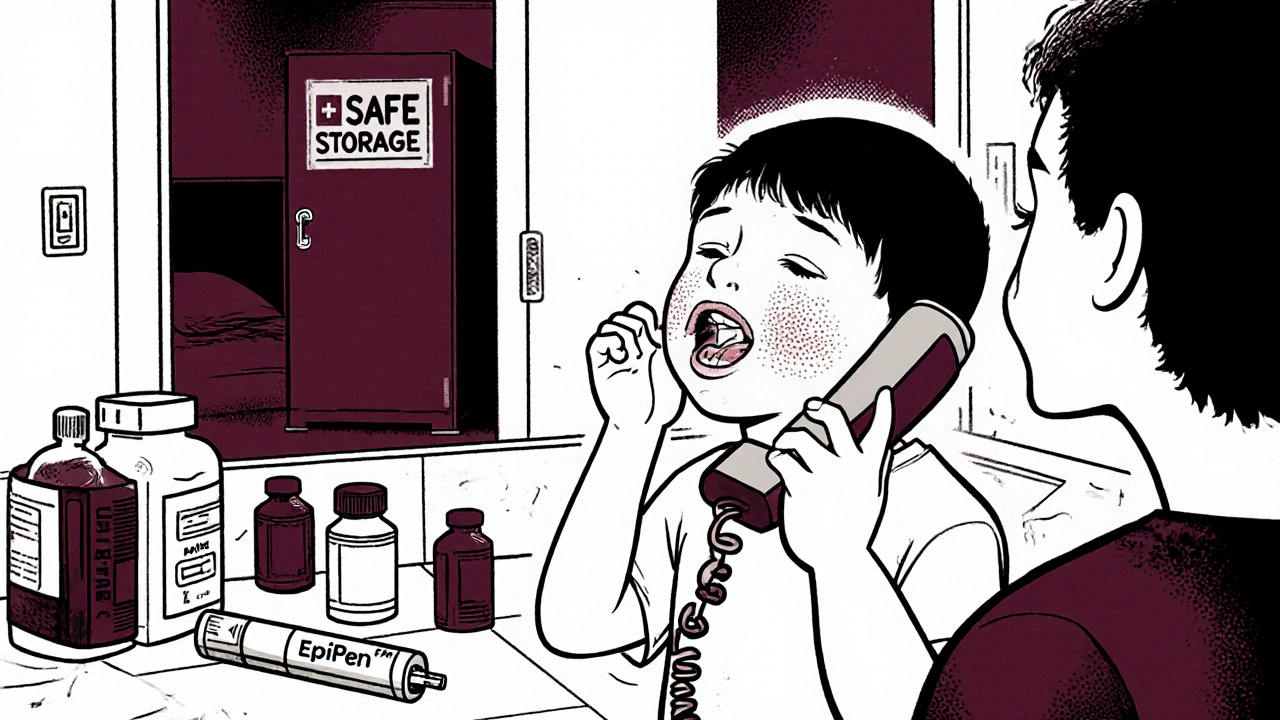
Use Technology Wisely
New tools are helping families manage meds better. Apps like MedTrak Pediatric, launched in late 2023, let you scan the barcode on the bottle to confirm the right dose and time. In trials, they cut dosing errors by 68%. Some apps also send reminders and let you log side effects to share with your doctor.But tech isn’t a replacement for attention. Always double-check the label. Even if the app says “5 mL,” look at the bottle. Make sure the color matches. Make sure the name matches. And if you’re unsure, call your pharmacy. Pharmacists are trained to catch these mistakes.
What to Do If You’re Not Sure
When in doubt, call poison control. In the U.S., it’s 1-800-222-1222. It’s free, confidential, and available 24/7. They can tell you whether a reaction is serious, whether you need to go to the hospital, or whether you can wait and watch. Don’t wait until your child is blue in the face to call. Call as soon as you’re worried.Also, keep a written list of all medications your child takes-names, doses, times, and why they’re taking them. Update it every time something changes. Bring it to every appointment. It saves time, reduces errors, and helps doctors connect the dots.
Future Improvements Are Coming
The system isn’t perfect. Right now, only 62% of medications have clear pediatric labeling. But change is coming. The FDA’s proposed Pediatric Medication Safety Act, introduced in September 2023, would require all drugs to include child-specific dosing and side effect info by 2027. Picture-based instructions are also being tested-early results show they could reduce errors by 79% in families with low health literacy.Genetic testing is starting to predict which kids are more likely to have bad reactions. It’s still early, but in the next few years, we may see personalized medication plans based on a child’s DNA. Until then, your vigilance is the best protection.
What should I do if my child vomits after taking medication?
Wait 30 to 60 minutes before offering anything. Start with small sips-5 to 10 mL of oral rehydration solution every 5 minutes. If they keep it down for an hour, slowly increase the amount. Don’t give more of the same medication unless your doctor says to. If vomiting continues for more than three times in 24 hours, or if signs of dehydration appear, contact your pediatrician.
Can I give my child over-the-counter medicine for side effects?
Only if your doctor says so. Many OTC drugs, like ibuprofen or antihistamines, can interact with prescription medications or make side effects worse. For example, giving extra diphenhydramine for a rash might cause excessive drowsiness or hyperactivity. Always check with your pediatrician before adding anything new.
How do I know if a rash is an allergic reaction?
A mild, flat, pink rash that appears a few days after starting a new medication is often harmless. But if the rash is raised, itchy, spreads quickly, or is accompanied by swelling of the face, lips, or tongue, or trouble breathing, it’s likely an allergic reaction. Call 911 immediately. If you have an epinephrine auto-injector, use it right away.
My child is acting hyper after taking medicine. Is that normal?
Yes, for some medications like diphenhydramine (Benadryl), hyperactivity is a known side effect in about 15% of children. It’s the opposite of what adults experience. Document the behavior-how long it lasted, what they were doing-and share it with your doctor. They may switch to a different medication.
What’s the best way to get my child to swallow pills?
Practice with candy. Start with small, soft candies like Nerds, then move to Mini M&Ms. Let your child practice swallowing them one at a time over 10-14 days. Nationwide Children’s Hospital found this method works for 89% of kids aged 8-12. Never crush pills unless your doctor says it’s safe. Some meds lose effectiveness or become dangerous when crushed.
Should I keep a medication log?
Yes. Write down the name of the medicine, the dose, the time you gave it, and any side effects you notice. This helps you spot patterns and gives your doctor valuable info. Many parents use phone apps, but a simple notebook works too. Bring it to every appointment.
Is it safe to store medication in the bathroom?
No. Bathrooms are hot and humid, which can break down medications. Most liquid pediatric drugs need to be stored at 20-25°C (68-77°F), and 73% require refrigeration. Store them in a cool, dry place like a bedroom closet, out of reach and in their original child-resistant containers.
What should I do if I think I gave the wrong dose?
Call poison control at 1-800-222-1222 immediately. Don’t wait for symptoms. Have the medication bottle ready so you can tell them the name, dose, and how much was given. They’ll tell you whether to watch, go to the ER, or do nothing. It’s better to call and be safe than to wait and risk harm.



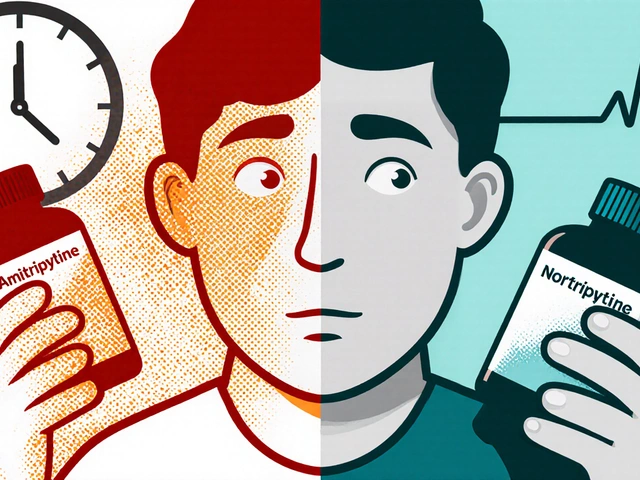
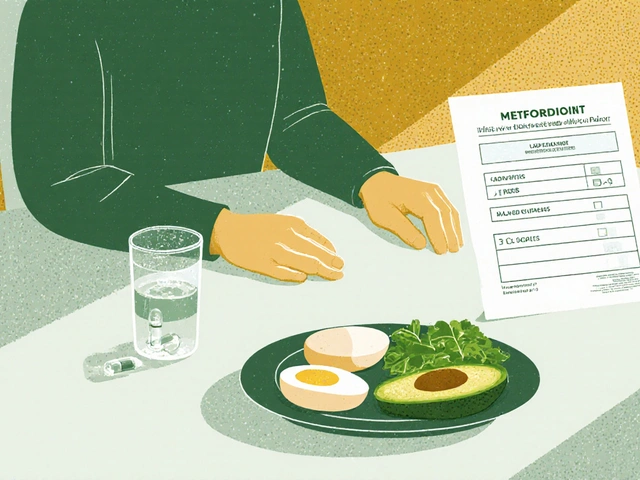
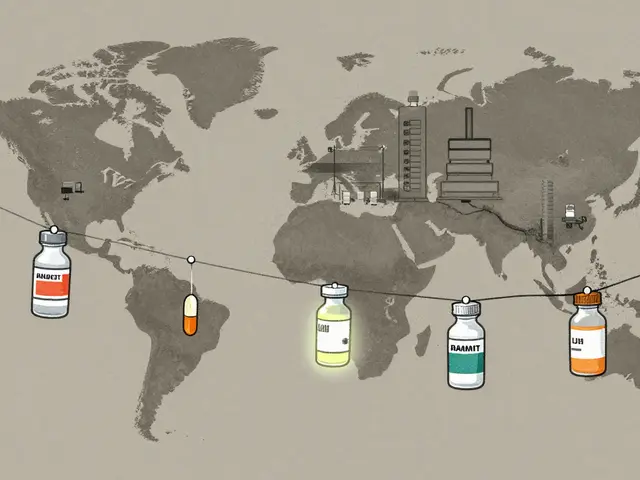


8 comments
Andrew Forthmuller
My kid threw up after amoxicillin. Called poison control. They said wait 30 mins, then give 5mL Pedialyte. Did it. No more puke. Saved my sanity.
Danae Miley
Let’s be real-most parents don’t know the difference between a teaspoon and a tablespoon. I used a kitchen spoon for months until my daughter got a 3x overdose of antihistamine. She was hyper for 12 hours. I bought 5 oral syringes. Now I label them with tape: ‘AMOX’, ‘ALLEG’, etc. This isn’t optional. It’s survival.
Charles Lewis
While the guidance provided here is largely accurate and grounded in empirical data, I would like to emphasize the broader systemic context in which these home-based interventions occur. The burden of medication management is disproportionately placed on caregivers-often mothers-who lack adequate support structures, time, or access to pediatric pharmacists. The fact that 68% of dosing errors stem from improper tools speaks not to parental negligence, but to the absence of standardized, universally distributed safety infrastructure. We need pharmacies to include syringes automatically with every pediatric prescription, and we need insurance to cover them without co-pays. The FDA’s proposed act is a step, but it’s reactive. We must be proactive. Until then, every parent is playing Russian roulette with a dropper.
Renee Ruth
So let me get this straight-hyperactivity from Benadryl is ‘normal’? That’s not a side effect, that’s a betrayal. My son turned into a screaming gremlin for 8 hours. I thought he was being possessed. I spent 3 days Googling ‘is my child possessed by demons after Benadryl’ before I found this post. And now I’m supposed to be grateful it’s ‘common’? No. This is a failure of pharmaceutical labeling. They should be forced to print ‘WARNING: MAY TURN YOUR CHILD INTO A DEMON’ on the bottle. I’m filing a complaint with the FTC.
Samantha Wade
I want to thank the author for this incredibly thorough and compassionate guide-it’s the kind of resource every pediatric office should hand out at the first prescription. I’ve been a nurse for 18 years, and I’ve seen too many families panic because they don’t know what’s normal. One thing I’d add: if you’re ever unsure, call your pharmacist. They’re not just dispensers-they’re trained medication safety experts who can explain side effects in plain language, often faster than your doctor’s office. I also keep a printed medication log in my purse, and I’ve had it save me twice when ER staff were confused. Don’t underestimate the power of a pen and paper. And to everyone reading: you’re doing better than you think. Parenting while managing meds is hard. You’re not failing. You’re fighting.
Elizabeth Buján
okay so i just gave my 5yo amoxicillin and she started twitching a little and i thought i killed her but then i remembered this post and checked the rash thing and it was just a little red spot and she was giggling so i’m like… maybe she’s just vibing? idk. but i took a pic of the bottle and wrote ‘8am, 5ml, red bottle’ on my hand with a sharpie. i’m a mess but i’m trying. also i use nerds to teach swallowing and now my kid thinks pills are candy. she’s 5. she’s gonna be a pharmacist. or a criminal. idk.
vanessa k
My sister gave her kid ibuprofen for a fever after antibiotics and he went into shock. We didn’t know they could interact. I wish someone had told us earlier. This post? It’s a lifeline. I printed it out and taped it to the fridge. No more guessing. No more panic. Just facts. Thank you.
manish kumar
As someone from India, I can tell you this advice is universal. In our rural areas, parents often crush pills and mix them in milk because the child refuses to swallow. We’ve seen cases of toxicity from that. We also store meds in the bathroom because there’s no closet. I’ve started sharing this guide with my community health group. We translate it into Hindi and Tamil. One mother said, ‘I thought the red bottle was for cough.’ Now she uses a syringe. Small changes. Big impact. Thank you for writing this. We need more of this-not just for America, but for the world.